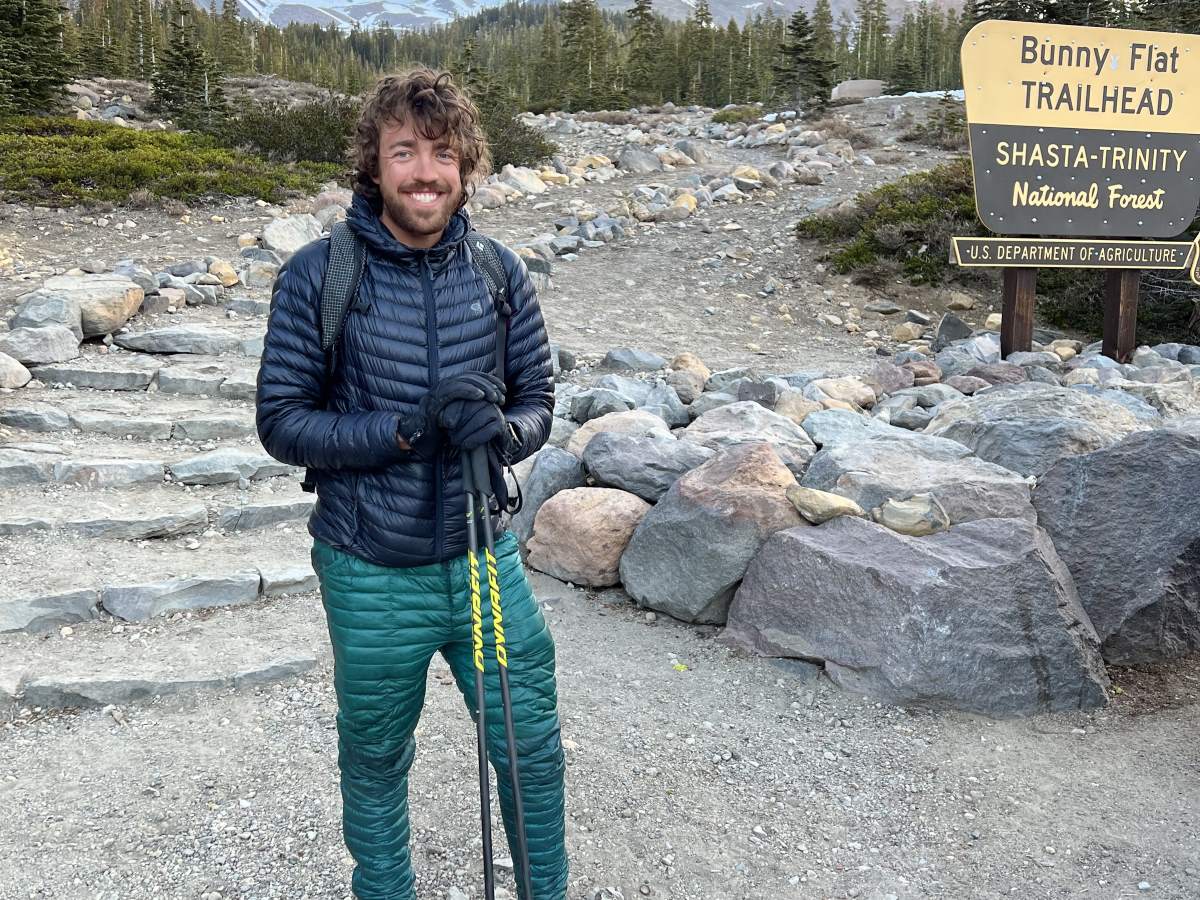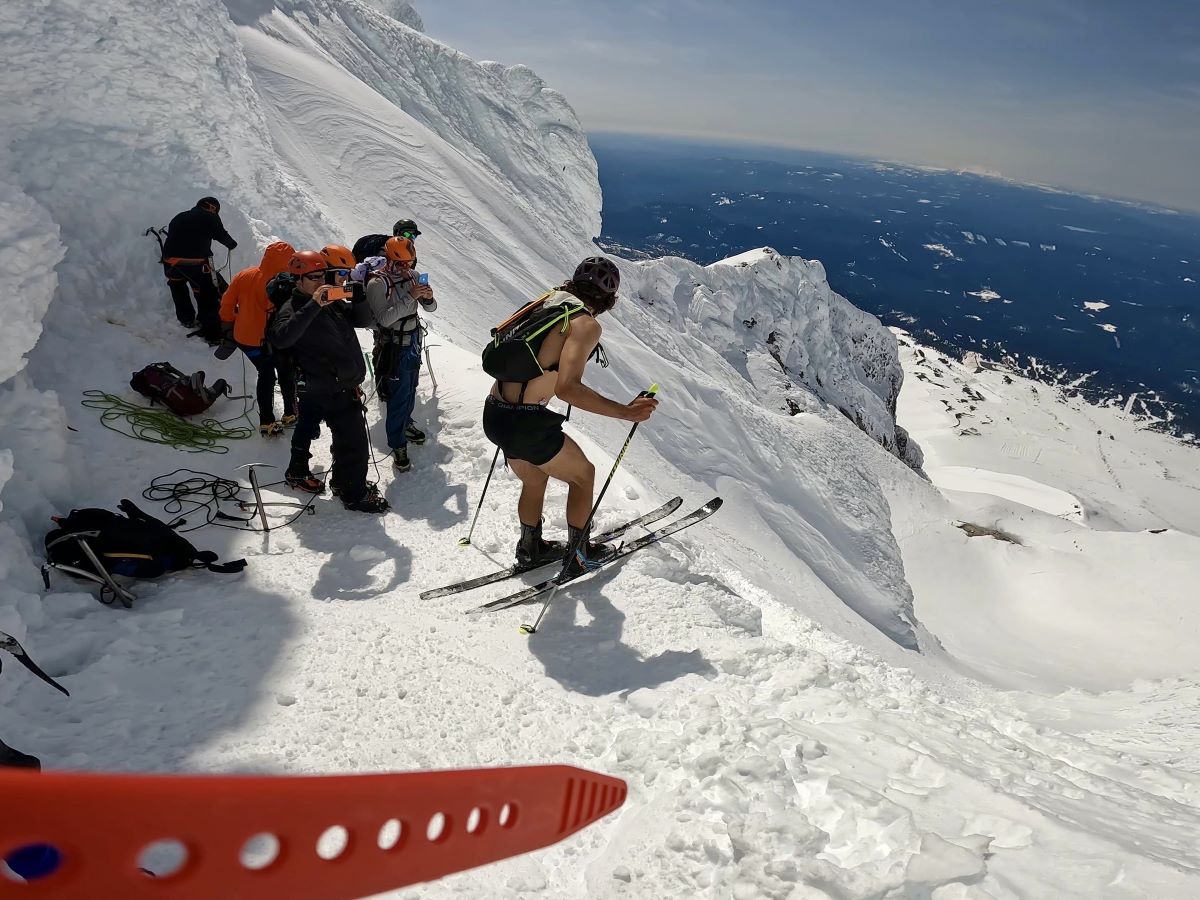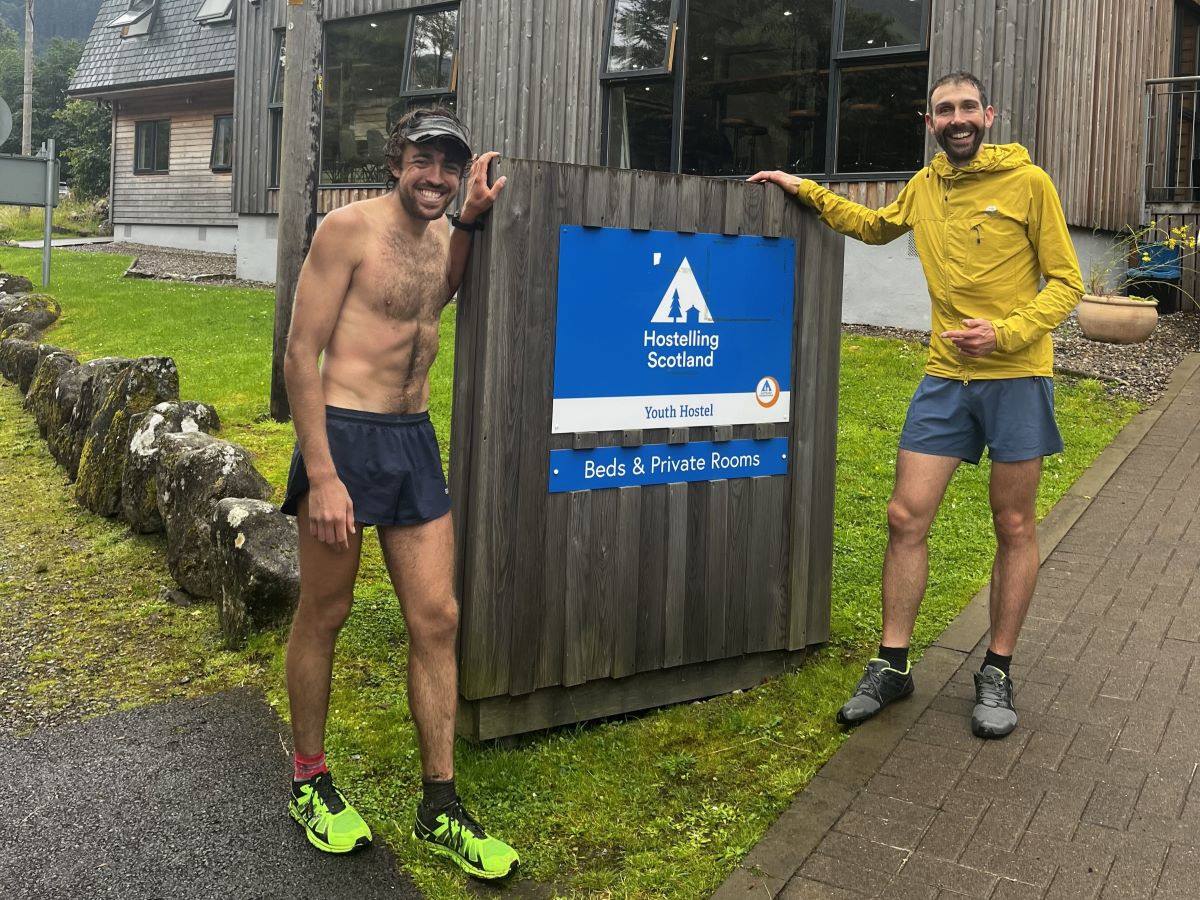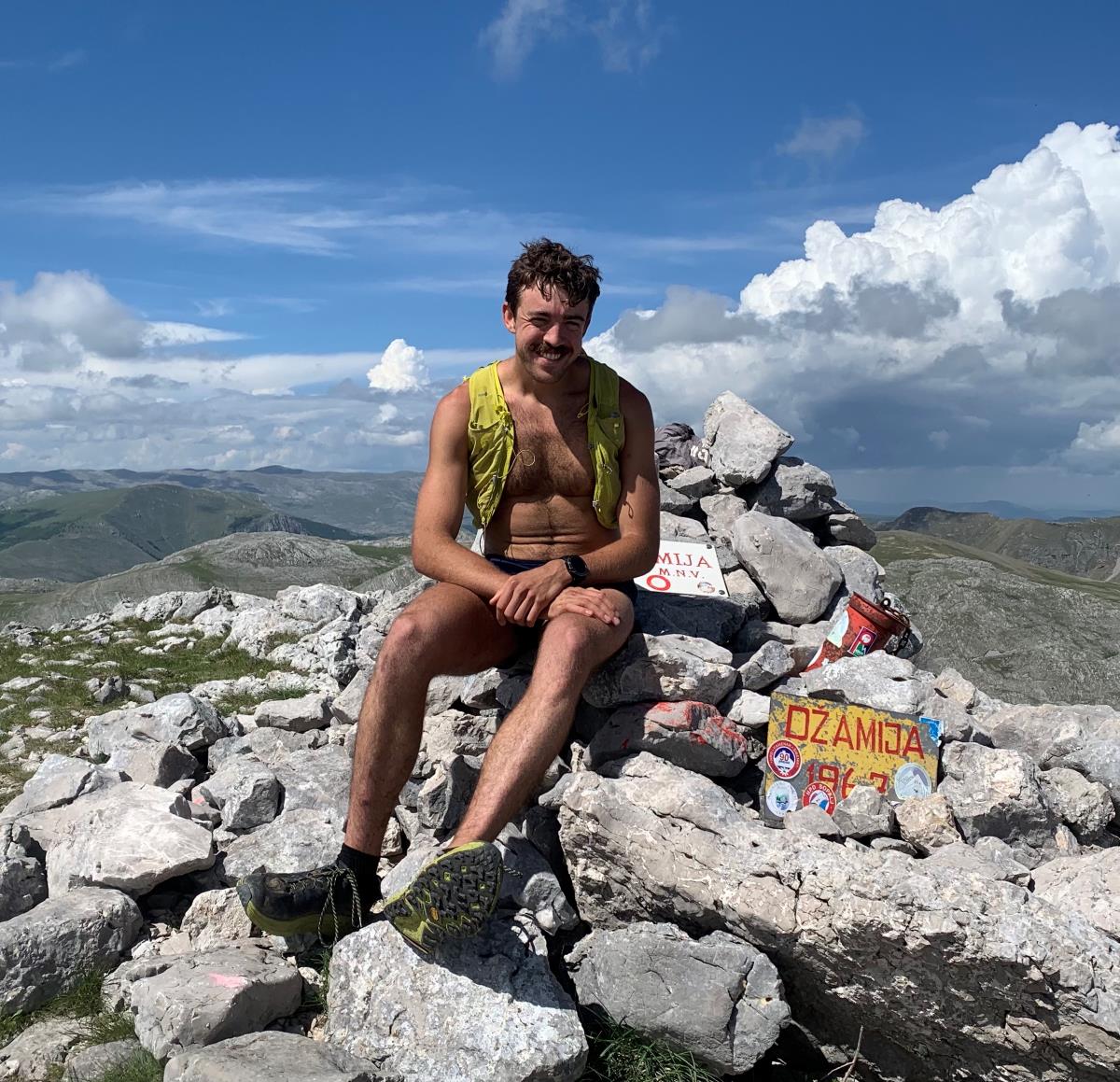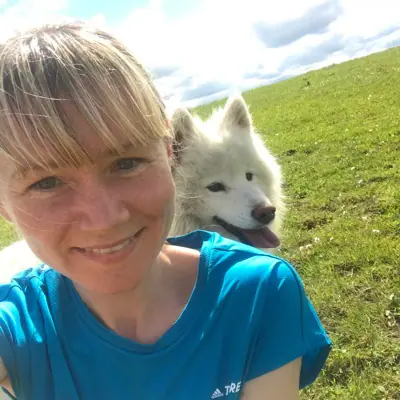On September 2, 2022, the international ultrarunning community did a double take when a new speed record was set on one of the most revered mountain routes in the world — the Bob Graham Round in the U.K.’s Lake District, a 66-mile loop that summits 42 fells and gains 27,000 feet of elevation. The record had been held since 2018 by none other than Kilian Jornet, who took it from British fell running legend Billy Bland, who had held it for 36 years.
But what made this new speed record more astounding was that it was set by neither a native mountain goat-like fell runner nor another international Jornet-type superstar — but by the relatively unknown and unsponsored American, Jack Kuenzle, who had been spending a few months living in a van and immersing himself in the U.K. fell running scene.
A few months on, when the dust had settled, I caught up with Kuenzle to find out more about his background in running, the round itself, and the set of circumstances that led to him setting out from Moot Hall in Keswick, England, on that Friday morning.
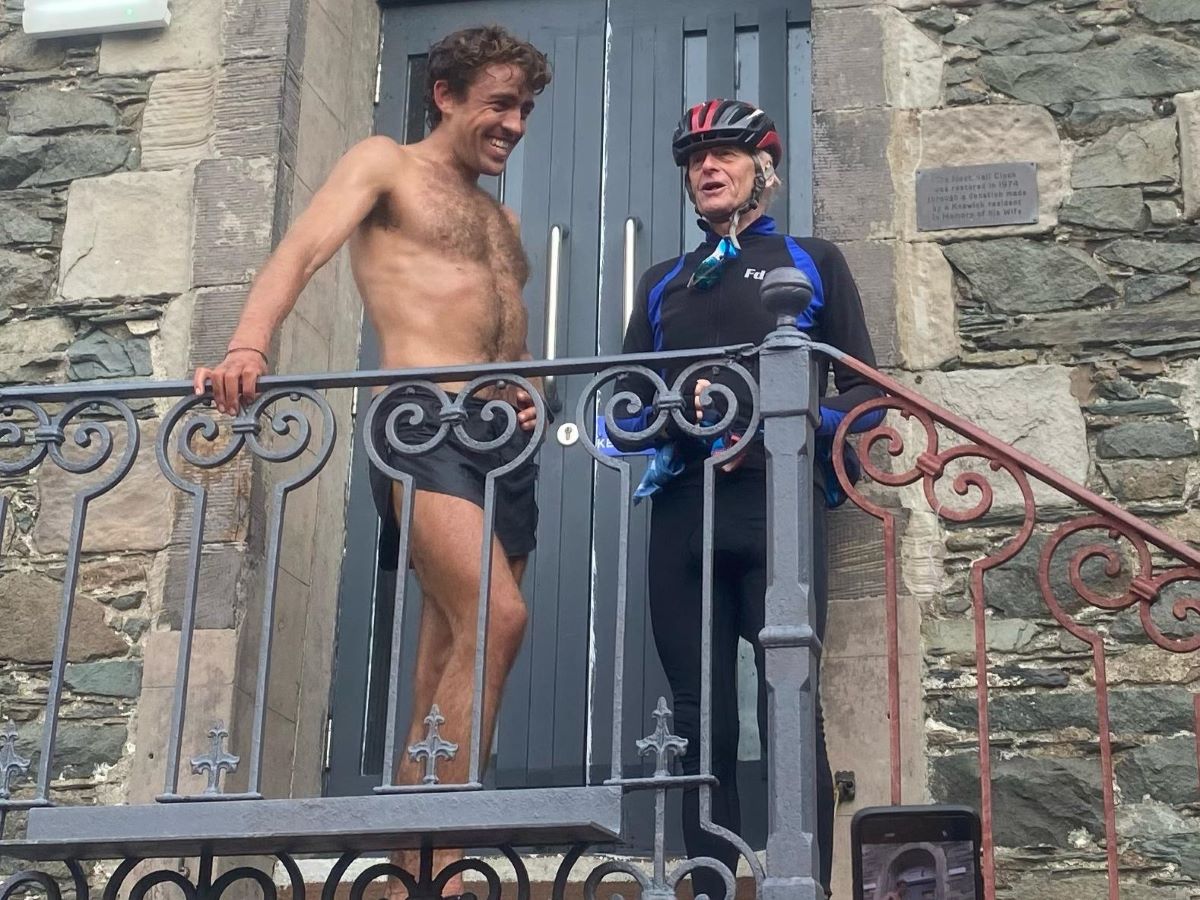
Jack Kuenzle (left) at the finish of the Bob Graham Round with former record holder Billy Bland. All photos courtesy of Jack Kuenzle unless otherwise noted.
Jack Kuenzle grew up in Connecticut, in the northeast United States. Growing up, he played ice hockey and ran cross country and track in high school, but he humbly pointed out, “I wasn’t all that good.” After high school, he joined the U.S. Navy, which funded his college education, after which he was required to serve for a time. He said, “I was lifting weights a lot, getting ready for [Navy service], I was running a lot. Also, I played club ice hockey in college. When I went into the military after that, I had to do a couple of years training that was quite physically intense.”
With already a lot of endurance training under his belt, he dabbled in ultramarathon running in 2018 and 2019 but wasn’t overly enamored with the format, saying: “Back in 2018, I did a 50 miler. It was decent, but I wasn’t too into it. Then in 2019, I did a handful of other races out to 100k distance. It was fine.” Although toeing a start line with hundreds of other runners wasn’t something that particularly appealed to Kuenzle, he did log some good results, winning the Iron Mountain Trail 50 Mile in 2019 and placing second in the Dead Horse Ultra 50 Mile and the Hellgate 100k that same year.
However, it wasn’t until he began to pursue fastest known time (FKT) projects that Kuenzle truly found his groove in the ultrarunning sphere. He said: “2020 and 2021 are when I really started focusing on FKTs. I started focusing on more mountainous FKTs. Then in 2021, I did a project to try to set records on all the most competitive one-day FKTs in the northeast United States.”
He points to this project as good preparation for his venture into U.K. rounds, saying: “That style of running is very similar to fell running. And that’s kind of where I got a better start.”
When he finished his service with the Navy in 2021, Kuenzle was able to incorporate a full ski season into his athletic year and said: “Before, I was skiing some, but I was living in Virginia, so I wasn’t able to ski all that much. So in 2021, I was able to ski full-time in the winter. I went for a handful of winter mountaineering-style FKTs out in the western U.S. Some on skis, some running on ice and snow.”
When the summer of 2022 rolled around, Kuenzle made a whimsical decision to head to the U.K. for what was originally planned to be a short trip. He recounts:
“I finished up a 100-mile project that I’d started in the northeast [the 104-mile section of the Appalachian Trail as it passes through the White Mountains]. I wasn’t able to finish it in 2021, but then I did finish it in June 2022. After that, I was originally planning to go out and run the Hardrock course — the Hardrock 100 route, but FKT style — but I was worried about the smoke. It ended up being a good smoke year, so it probably would have been ok to do it, but I didn’t.”
He continued, “My dad used to be a pilot for Delta Airlines, so I could fly very cheap and last minute, and I’d always thought about doing some of the speed records in the U.K. So I just decided on a whim to fly out. Originally the intention was to just do the Ramsay Round and to come back a couple years later and do the Bob Graham Round once I was more experienced. But I bought a van, and I had to buy car insurance, and it was £200 a month, and the minimum I could buy was three months, so I was committed [to stay a bit longer]. So I said I’ll do the Bob, or if I think the Bob [speed record] is too fast, I’ll find something else to do.”
The first port of call for Kuenzle in the U.K. was the Ramsay Round in Scotland, which, over 58 miles, summits 24 mountains and climbs around 28,500 feet. But instead of the full route, he opted to run the Tranter Round — a shorter variation of the Ramsay, for which Scottish hill runner Finlay Wild held the speed record. Wild also holds the record for the longer Ramsay Round and had contested Jornet’s Bob Graham Round record in 2021 but came up seven minutes short — running 12:59 to Jornet’s 12:52, for what is still the third fastest time on record.
Kuenzle spent some time getting to know the routes and said: “I ended up doing the Tranter.” This lesser-known variation of the Ramsay Round takes in 19 mountains over about 37 miles with 18,000 feet of climbing. It has a longer history than the full Ramsay Round, and as Kuenzle outlines: “The first 24-hour record in Scotland on the Munroes was the Tranter, that was in the early 1960s. Then in the ’70s, Charlie Ramsay did the Ramsay Round, which is an extension. It just adds five peaks onto the Tranter Round.”
He explained why he opted for the shorter Tranter Round, saying: “I didn’t like the Ramsay very much. The additional five peaks it adds, they’re not very aesthetic. It’s kind of nasty running, it’s like heather, up and down. It’s not very pleasant. … The Tranter does have a huge history of competition, and Finlay Wild’s record on the Tranter was arguably better than his record on the Ramsay, so it was a worthwhile goal.” Kuenzle ended up taking 14 minutes off Wild’s 8:52 record on the Tranter Round, and this result was part of what planted the seed for his attempt at breaking Kilian Jornet’s Bob Graham Round record.
He said: “My thought was Finlay’s time on the Tranter because he had raced it multiple times, and it was in his backyard, I figured his time on the Tranter was better than his time on the Bob. Also, I felt like Finlay was probably better at the shorter stuff relative to me, as a lot of the fell racing he does is shorter. So I figured that as the distance got further along, I would probably do a little better.” He went on to say, “I think if you were to look at my time on the Tranter alongside Finlay’s times on both, you could probably accurately predict what time I was going to do the Bob in.”
To test his theory a little further before committing to the effort, Kuenzle — who was still at the time in Scotland — calculated the height gain to distance ratio of the Bob Graham Round and the pace required to break the record and ran a similarly paced 20-mile run in the Pentland Hills — which have somewhat similar terrain to the Lake District. He said, “It was just a normal aerobic run for me, just to feel it out. And after that, I was like, maybe [I could run the Bob Graham Round speed record].”
One rule of the Bob Graham Round is that all aspiring rounders must have at least one pacer accompany them to each summit — a tradition that began for safety and verification in the days preceding GPS tracker technology. Also, the rules allow pacers to carry whatever nutrition and gear the runner requires, so it has become the norm for runners attempting a fast round to avail of this and carry nothing on their person.
Kuenzle set about recruiting a team of fast pacers. From scouting around at local fell races and inquiring with clubs, he had compiled a list of some 50 prospective pacers, but under the understanding that he would run at the weekend and not before September 9. When due to weather and other factors, he ended up running on Friday, September 2, it was a scramble to find anyone available to pace. He said, “Fortunately, I whined enough … and eventually, I got enough people to come out of the woodwork and help!”

Kuenzle with some of his Bob Graham Round pacers (l-to-r): Jonny Cox, Jack Kuenzle, Matt Atkinson, and Jack Eyre.
On the day of the round, Kuenzle planned to avoid falling into the pitfall of many past runners by starting too fast and was satisfied to split the first leg slower than Jornet’s time. He was of the opinion that when Billy Bland set the original record, Bland had started very aggressively, and it was likely that all subsequent challengers to the record had followed suit in trying to match Bland’s early splits.
Speaking of the fast men who had attempted the round in the past, Kuenzle said: “Everyone seemed to blow up by Grey Knotts on Leg 4, so I think they certainly went out too quickly.”
He also aimed to make up time by moving efficiently through the transitions and said: “For whatever reason, Kilian stopped [for several minutes] at some of the road crossings. I think maybe tactics in ultrarunning were just a little bit different back in 2018.”
He recalls: “I split Leg 1 eight minutes slower than Kilian. On the first peak of Leg 2, we were still two minutes behind Kilian. We tried to match that split but missed it, so after that, I made a determination, I need to beat Kilian on these next couple of splits, just because I needed the confidence. So I told my crew we were going to hammer the next couple of splits, and we did that. I was feeling pretty good, and by the time we got to Dunmail Raise [at the finish of Leg 2], we had brought the pace down to something pretty manageable, and we were still gaining on [Jornet’s time]. That was when I started to feel that I could probably do it — which was only like hour four, really.”
He went on: “I knew myself well enough that unless I fell or something, I wasn’t going to blow up.”
The route ends with a road section into Keswick, which many find soul-destroying, owing to the discomfort of switching gears back to road running after a day on the fells. Kuenzle recounts, “I had been dreading the last road miles so much that when it happened, it really wasn’t that bad. I think it just felt good being so far up on the record, knowing I’d get it.” At this point, he was almost half an hour ahead of Jornet’s time, meaning he could cruise the last few miles as a victory lap before finally touching down in Moot Hall in a time of 12 hours and 23 minutes.
Kuenzle felt indebted to his team of crew and pacers. In the traditions of the Bob Graham Round, he returned the favor a week later in pacing another runner on their round, which gave him an insight into the demands of the task. He said: “It was really hard to do. Because you aren’t in the same headspace as the runner, you’re carrying all their stuff, and you’re trying to do the thinking for them. It’s a lot of pressure. It’s really, really hard to do.”
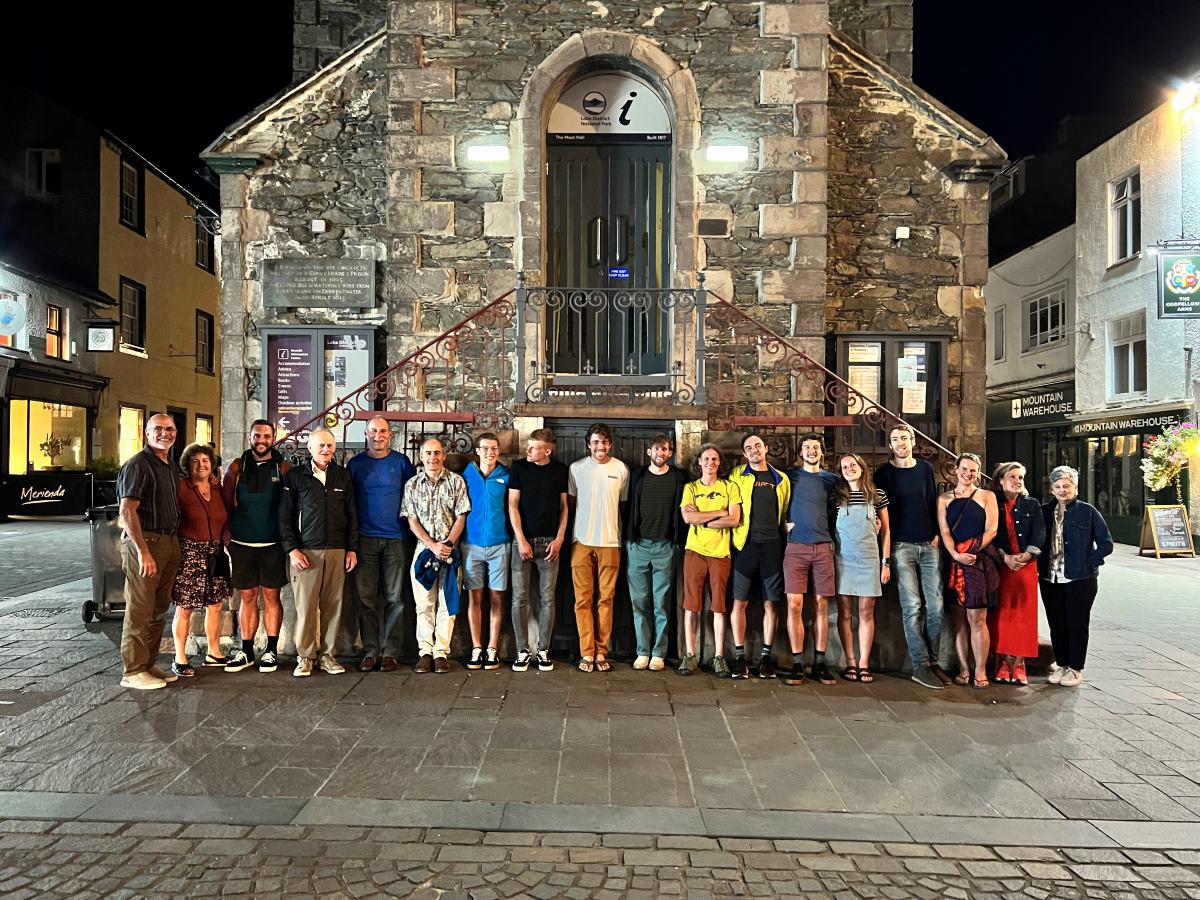
Jack Kuenzle (center, white shirt) with his crew at Moot Hall, where the Bob Graham Round starts and ends in Keswick, England.
After the round, he needed a little timeout and said: “It took me a while to recover. I started training pretty decently a week later. I trained for two or three weeks, and then I ended up having to take 10 days off at the beginning of October as I was so burned out.” He also said that, as someone with a focus on FKTs rather than races, it was hard to know where to go next — as he considered the Bob Graham Round to be the “world championships of speed records.” He said: “As far as speed records go, broadly, unless you go for the Appalachian Trail, the Bob Graham is pretty much the pinnacle. There are other fast efforts out there, but in terms of historical significance and everything, the Bob Graham Round is pretty much the peak.”
Although he points to Kilian Jornet’s run as the time when the Bob Graham Round first piqued his interest, he added: “I think Jasmin [Paris] first started the golden era of the Bob Graham.” In 2016, Paris set the women’s record on the round in 15 hours 23 minutes, taking more than two-and-a-half hours off Nicky Spinks’s previous best. He continued, “[Jasmin Paris] did it in 2016, Kilian Jornet did it in 2018, and then Beth [Pascall] did it in 2020. And then Finlay Wild attempted it in 2021, and now Tom Evans is going to do it in 2023.”
Kuenzle has kept in touch with Jornet, who reached out to congratulate him on his record, and also with Wild, who played a big role in his U.K. adventure. Far from being too guarded or territorial of his speed record, Kuenzle said: “Personally, I would love to see Kilian or Finlay do the Bob Graham Round again.”
Looking forward to his own plans, he said, “I think I will definitely do something else in the U.K., maybe in preparation for the Lakeland 24-hour speed record.” He has also been looking at racing Trofeo Kima in 2024 and is exploring the possibility of spending that year in Europe.
You still won’t find out much about Jack Kuenzle from looking at race results — owing to a lack of recent races, his current International Trail Running Association (ITRA) performance index is 0 — or sponsored content — he’s not interested in that aspect of the sport. But he has nonetheless proved himself to be up there with the best mountain ultrarunners in the world.
Call for Comments
- Were you following this Bob Graham Round speed record story? Were you impressed?
- Have you seen Jack Kuenzle in action otherwise?
